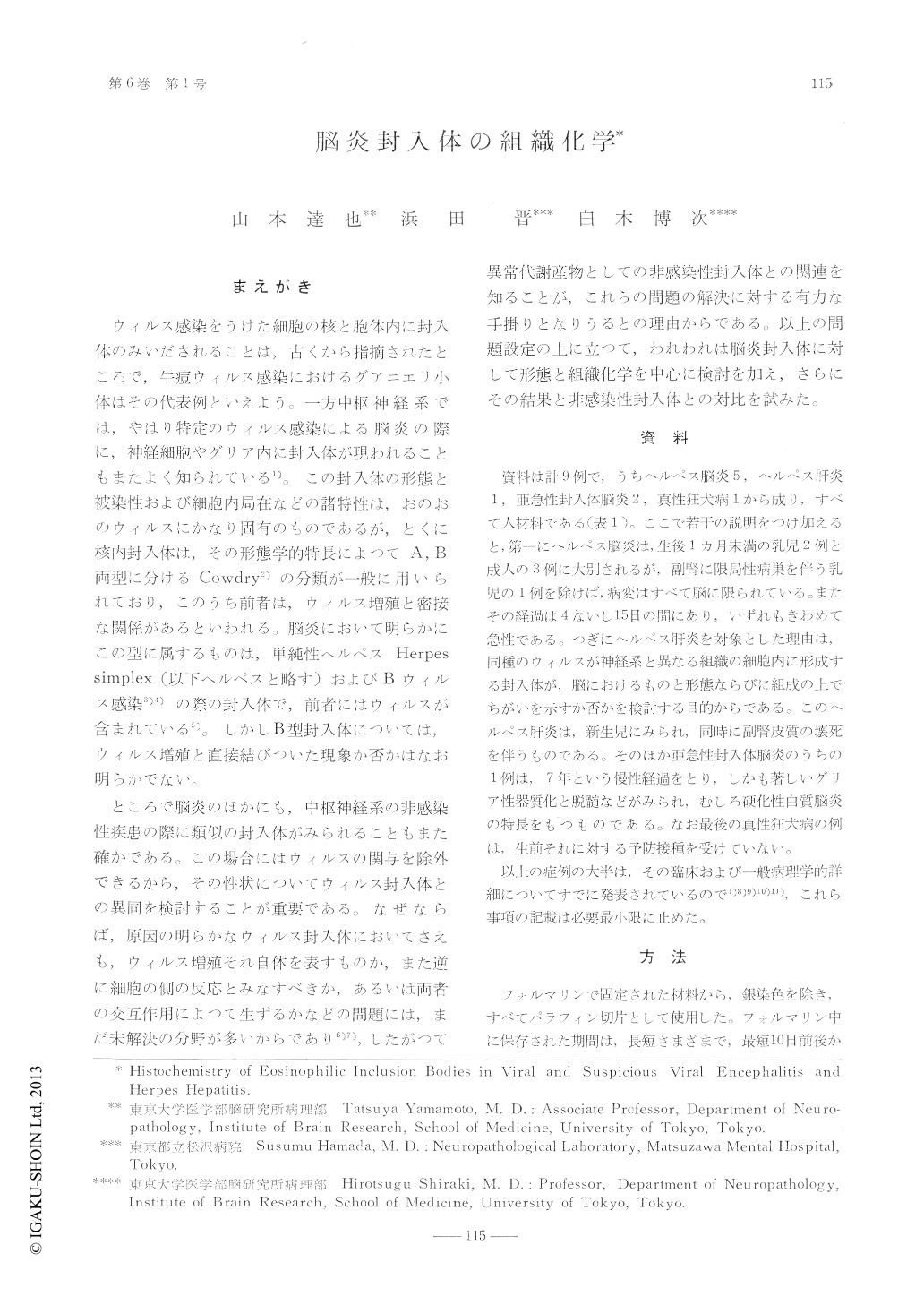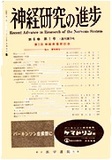Japanese
English
- 有料閲覧
- Abstract 文献概要
- 1ページ目 Look Inside
まえがき
ウィルス感染をうけた細胞の核と胞体内に封入体のみいだされることは,古くから指摘されたところで,牛痘ウィルス感染におけるゲアニエリ小体はその代表例といえよう。一方中枢神経系では,やはり特定のウィルス感染による脳炎の際に,神経細胞やグリア内に封入体が現われることもまたよく知られている1)。この封入体の形態と被染性および細胞内局在などの諸特性は,おのおのウィルスにかなり固有のものであるが,とくに核内封入体は,その形態学的特長によつてA,B両型に分けるCowdry2)の分類が一般に用いられており,このうち前者は,ウィルス増殖と密接な関係があるといわれる。脳炎において明らかにこの型に属するものは,単純性ヘルペスHerpessimplex(以下ヘルペスと略す)およびBウィルス感染3)4)の際の封入体で,前者にはウィルス含まれている5)。しかしB型封入体については,ウィルス増殖と直接結びついた現象か否かはなお明らかでない。
ところで脳炎のほかにも,中枢神経系の非感染性疾患の際に類似の封入体がみられることもた確かである。この陽合にはウィルスの関与を除外できるから,その性状についてウィルス封入体との異同を検討することが重要である。
In a series of comparative studies on eosinophilic inclusion bodies in various central nervous system diseases, the present attempt was concentrated into elucidating an exact nature of viral inclusions from both morphological and histochemical viewpoint.
The materials comprized 5 of herpes encephalitis, 1 of herpes hepatitis, 2 of subacuteinclusion encephalitis and 1 of genuine rabies (Table 1).
The results obtained were summarized as follows;the common histochemical constitution of inclusions in each disease and their different selectivities of both cellular and intracellular localisation (Tables 2-9;Figures 1-7).
The acidophilic inclusion bodies in the nuclei of both nerve cells and oligodendroglia in herpes encephalitis and hepatitis represented a striking feature of "A type". Their morphological pattern and specifity of cellular localisation resembled closely those of subacute inclusion encephalitis. Whereas, the latter is differenciated from the former with respect to the morphological multiplicity in association of intracytoplasmic bodies in nerve cells. The Negri bodies were, as a rule, independent of the distribution of inflamatory tissue response and always confined to cytoplasm and dendrite of nerve cells.
In both elderly patients and hepatocerebral diseases the inclusions were usually encountered in the nuclei of nigral cells. In a suspicious case of "cerebral form"of Wilson's disease the similar inclusions were frequently found in both nuclei and cytoplasm of astrocytes and nerve cells, and occasionally in the nuclei of adventitial and ependymal cells, but never seen in oligodendroglia. Furthermore, the same cellular localisation of inclusions was observed in a case of cytomegalic inclusion disease with cerebral involvement. Judging from the abovementioned findings,it may be assumed that the eosinophilic inclusions represented a site of predilection in nerve cells under both inflamatory and non-inflamatory processes, while those in glial cells, vessel wall and ependyma differed in each. It is not overlooked that the distribution of neuronal cells containing inclusions varied in each disease. For example, inclusions were predominant in substantia nigra in elderly patients, in both Ammon's horn and Purkinjecell in genuine rabies and in cerebral cortex in viral encephalitis.
The principal histochemical characteristics of the inclusions in encephalitic cases were as follows : Negative reaction for polysacchrides (PAS, Best-Carmin, Alcian blue) and lipids (Sudan black B, performic acid-Schiff), positive reaction for proteins (Hg-bromphenol blue) and similar isoelectric points by staining at controlled pH in each. Amino-acids such as tyrosine, tryptophan, arginine, cysteine or cystine (coupled tetrazonium and its blocking, Millon, Sakaguchi, alkaline tetrazolium) were fairly in common on each intranuclear inclusion body. As to cytoplasmic ones, however, the reaction for sulfur-containing amino-acids showed a remarkable difference between subacute inclusion encephalitis and genuine rabies. Reaction for nucleic acids (Feulgen, gallocyanin, methyl green-pyronin) was slightest to moderately positive in the acute herpetic cases.
In comparison with a histochemical feature of two groups of the diseases, i.e., inflamatory and non-inflamatory, an only minor difference could be pointed out in regard with a slight positive reaction for polysaccharides and lipids in the latter. It may be reasonable, therefore, in assuming that eosinophilic inclusion bodies are actually non-specific byproducts and represent a kind of pathomorphological expression for certain disturbed protein metabolism at the level of neuronal cells.
A question then may arise to what kind of factors could influence upon two different developmental mechanism of inclusion bodies in each disease, i.e., their common histochemical constituents and different selectivities of both cellular and intracellular localisation. In this connection it may be assumed that these final patterns are determined by an interaction of metabolic property of cell elements and various kinds of extrinsic agents including different neurotropic activity of each virus etc.

Copyright © 1962, Igaku-Shoin Ltd. All rights reserved.


